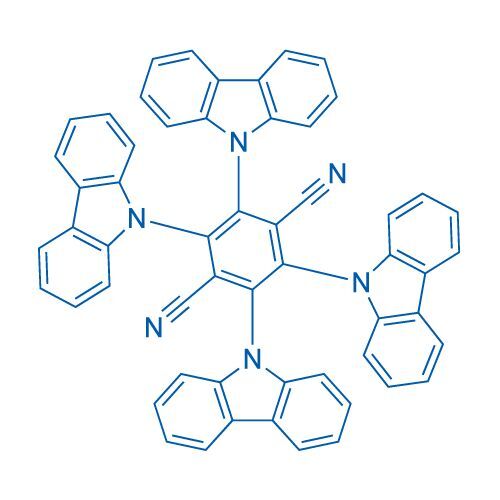4CzTPN -1g / 1g
Safety Information
Hazard Statements
Precautionary Statements
Pictograms
Properties
| Signal Word | Warning |
Product Description
4-CzTPN, or 2,3,5,6-tetra(9H-carbazol-9-yl)terephthalonitrile, is a specialized organic compound recognized for its outstanding thermal stability and compatibility with various organic solvents. This compound is integral in the production of materials for electroluminescent devices, such as OLEDs (Organic Light Emitting Diodes), due to its ability to facilitate efficient electron and hole transport. Its molecular design supports broad spectral coverage, making it suitable for applications in optoelectronics where color accuracy and brightness are critical. Moreover, its chemical robustness and high oxidative stability position it as a reliable component in environments demanding durability and longevity.
Application
In the realm of electronics, 4-CzTPN stands out for its utility in enhancing the performance of OLED displays through improved charge carrier mobility and reduced operational voltage. Its application is not limited to display technology; it also contributes significantly to the advancement of OPV (Organic Photovoltaic) systems by optimizing the collection of photogenerated charges, thereby increasing the overall efficiency of solar cells. Beyond these specific uses, the compound's versatility in material science suggests potential applications in sensor technologies and photodetection, areas where its optical and electrical properties can be leveraged to develop innovative solutions.
Articles:
- Local-Excitation versus Charge-Transfer Characters in the Triplet State: Theoretical Insight into the Singlet–Triplet Energy Differences of Carbazolyl-Phthalonitrile-Based Thermally Activated Delayed Fluorescence Materials
Publication Date: November 21, 2016
Kyungeon Lee, Dongwook Kim
https://doi.org/10.1021/acs.jpcc.6b10161
- 4CzIPN-tBu-Catalyzed Proton-Coupled Electron Transfer for Photosynthesis of Phosphorylated N-Heteroaromatics
Publication Date: December 29, 2020
Yan Liu, Xiao-Lan Chen, Xiao-Yun Li, Shan-Shan Zhu, Shi-Jun Li, Yan Song, Ling-Bo Qu, Bing Yu
https://doi.org/10.1021/jacs.0c11138
- Carbazole Derivatives with Thermally Activated Delayed Fluorescence Property as Photoinitiators/Photoredox Catalysts for LED 3D Printing Technology
Publication Date: June 28, 2017
Assi Al Mousawi, Diego Magaldi Lara, Guillaume Noirbent, Frederic Dumur, Joumana Toufaily, Tayssir Hamieh, Thanh-Tuan Bui, Fabrice Goubard, Bernadette Graff, Didier Gigmes, Jean Pierre Fouassier, Jacques Lalevée
